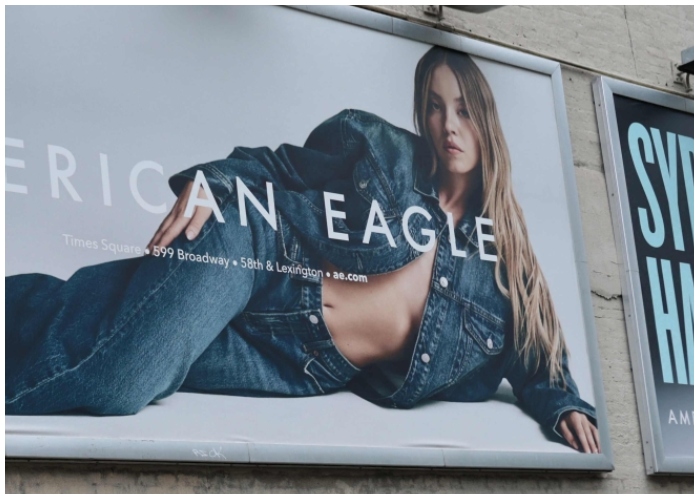American Eagle’s latest ad featuring Sydney Sweeney was supposed to be fun and flirty, but it backfired into one of the most criticized campaigns in recent memory. The tagline, “Genes are passed down… My jeans are blue,” might have seemed like a harmless pun in the boardroom, but out in the world it ignited a cultural debate. It’s not the first time an ad has been tone-deaf, but this one hit a nerve—and for good reason. Pairing that phrase with the image of a white, blue-eyed, conventionally attractive woman in denim carried connotations that the brand either didn’t recognize or willfully ignored. In a time when messaging is under the microscope and brands are expected to show social awareness, American Eagle missed the mark not by accident—but by underestimating how smart and critical audiences have become.
A Visual That Spoke Louder Than Words
The campaign’s biggest misstep wasn’t just the tagline—it was the visual pairing of that line with Sweeney’s image. It reinforced a narrow, outdated standard of beauty at a time when many consumers are asking for broader representation. It felt like a regression. While no one is blaming Sweeney personally for how she looks, the choice to lean into “genetic” language with such a loaded visual didn’t sit right. It harked back to eras of advertising where whiteness was not just centered but glorified—and in a post-2020 marketing world, that tone simply doesn’t pass quietly.
Context Is Everything in the Attention Economy
American Eagle might claim innocence, but in 2025, marketing doesn’t happen in a vacuum. We’re in an era where every campaign is dropped into a hyper-aware digital ecosystem. People don’t just consume ads anymore—they dissect them, meme them, cancel them, or reclaim them. That kind of engagement can be powerful, but it’s also volatile. Brands should know that even a light pun can carry unintended weight when it plays with language historically tied to exclusion, privilege, and appearance. Choosing to ignore that context isn’t creative freedom—it’s calculated ignorance.
Outrage as Marketing Strategy
Here’s where it gets uncomfortable: the campaign worked. It generated clicks, headlines, and a flood of discourse. Stock rose briefly. Influencers jumped into the debate. The brand trended. This wasn’t just a misstep—it was arguably a gamble.

The new marketing math suggests that outrage equals visibility, and visibility equals attention, and attention—no matter how critical—boosts brand awareness. But short-term virality comes with long-term consequences. You don’t build loyalty with shock value. You build fatigue. Audiences are smart enough to know when they’re being played for engagement, and once they feel manipulated, they don’t come back.
Branding in the Age of Meaning
What many brands fail to understand is that younger consumers, especially Gen Z, are not just buying clothes—they’re buying values. They want to support brands that align with their social beliefs, not ones that play both sides or push buttons for profit. In this case, American Eagle didn’t just fail to deliver meaningful messaging—they avoided it altogether. The ad said nothing about identity, community, or belonging. It had no voice or perspective. It was fluff dressed up in controversy, and it felt hollow. That kind of branding might have worked in the early 2000s, but not now.
A Moment That Could’ve Meant Something
There’s also a missed opportunity here. Denim is about heritage, history, identity. There are so many powerful ways to talk about jeans—how they connect generations, how they’re worn across cultures, how they evolve with you. Instead, the campaign reduced it all to a pun that alienated rather than celebrated. This moment could’ve been an inclusive reflection on what jeans mean to different people, or a platform for broader representation. Instead, it was a conversation-starter for all the wrong reasons.
The Problem Isn’t Sensitivity—It’s Oversimplification
Whenever a campaign gets called out, someone inevitably argues that people are “too sensitive” now. But that’s not the real issue. The problem isn’t that audiences are sensitive—it’s that the marketing is lazy. A pun isn’t offensive on its own, but when it’s used without care or context, it opens the door to misinterpretation. In a world flooded with content, people aren’t just looking for attention—they’re looking for intention. Brands that ignore that shift will find themselves on the wrong side of cultural conversation every time.
What This Says About Where We’re Headed
This controversy is about more than jeans. It’s about the future of brand responsibility. Companies can no longer afford to be passive or oblivious to how their messaging lands. Visuals, language, casting—every choice matters. If you don’t take the time to consider your impact, someone else will call you out for it. The bar has been raised, and it’s not coming back down.